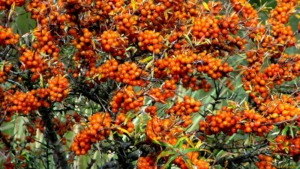Carotenoids
The pulp of sea buckthorn fruits is rich in large quantities of various carotenoids, which act as an antioxidant and helping to synthesize and epithelialize collagen.
The total amount and the occurrence of different types of carotenoids is highly variable depending of the genetic origin, conditions of cultivation, climate, and harvesting time. A total carotenoid content of a Romanian H. rhamnoides variety of 860 mg/kg dry weight of berries was reported, identifying zeaxanthin dipalmitate and other zeaxanthin esters, β-carotene, non-conjugated zeaxanthin, lycopene and β-cryptoxanthin palmitate as dominant carotenoids.
12 compounds of the carotenoid class were reported when analyzing sea buckthorn fruits from ssp. Carpatica, as follows: astaxanthin, zeaxanthin, zeaxanthin palmitate, γ-carotene, cis β-carotene, β-cryptoxanthin, lycopene, myristo-lutein palmitate lutein di-palmitate, β-carotene, α-carotene, and zeaxanthin di-palmitate.
 By far, zeaxanthin was quantitatively the most important of the identified carotenoids (81.29 mg/g dry weight), followed by β-carotene (15.19 mg/g dry weight), astaxanthin (11.94 mg/g dry weight), β-cryptoxanthin (8.93 mg/g dry weight), and lycopene (2.24 mg/g dry weight).
By far, zeaxanthin was quantitatively the most important of the identified carotenoids (81.29 mg/g dry weight), followed by β-carotene (15.19 mg/g dry weight), astaxanthin (11.94 mg/g dry weight), β-cryptoxanthin (8.93 mg/g dry weight), and lycopene (2.24 mg/g dry weight).
On the other side, a β-carotene content in sea buckthorn fruits of Chinese variety of 100 mg/kg fresh weight was reported, higher than that of pumpkin and double that of carrots, and this concentration does not decrease after the fruit is frozen. In addition, after comparing different species of sea buckthorn from Indian Himalayas regarding their carotenoids content. it was reported that berries from Hippophaë rhamnoides produced the highest amounts of carotenoids compared to H. tibetana and H. salicifolia.
The carotenoid content is one of the key characteristics by which sea buckthorn oil is traded commercially. Carotenoids in oil vary widely depending on the source of the oil from 0.5 to 21.4 g/kg.
Vitamin E
Tocopherols and tocotrienols, commonly known as vitamin E, are important bioactive components in sea buckthorn berries, which have a significant antioxidative effect. The level of Vitamin E in berries depends on origin, variety, harvesting time, and maturation. In comparison with other fruit and vegetable, sea buckthorn berries are a rich source of vitamin E, especially α-tocopherol. The content of vitamin E in sea buckthorn is higher than in the germs of wheat, saffron, corn, and soybeans, The range of total content of vitamin E in H. rhamnoides ssp. sinensis and ssp. mongolica is 56–140 mg/kg fresh weight and 1.5–8.1 mg/kg fresh weight, respectively, α-tocopherol being the dominant tocopherol (76–89% of total tocopherols).
On the other side, both sea buckthorn seed oil and pulp oil are rich in α- and γ-tocopherols (444–1550 mg/kg and 461–1349 mg/kg of seed oil and 630–1940 mg/kg of α-tocopherols in pulp oil) compared to other vegetable oils such as virgin olive oil (98–370 mg/kg), sunflower oil (432 and 92 mg/kg), corn oil (173 and 260 mg/kg), canola oil (120 and 122 mg/kg), and soybean oil (71 and 273 mg/kg).
Additionally, a high content of total tocopherols in sea buckthorn oil was also reported: each 100 g of sea buckthorn oil contains 206.9 mg of vitamin E, the whole berry oil from H. rhamnoides cultivars contained 1014–1283 mg/kg of total tocopherols, in which α-tocopherol was 62–68% and δ-tocopherol 32–38% of total tocopherols.

Leave A Comment